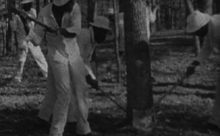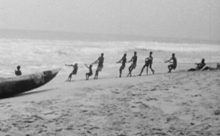The Pete and Toshi Seeger Film Collection
In David Dunaway's biography of Pete Seeger, How Can I Keep from Singing, Pete Seeger describes how, in 1939, Alan Lomax, assistant-in-charge of the Archive of Folk Song, hired him for "fifteen dollars a week." "His duties were untaxing -cataloging the dusty archives and transcribing songs. In the process he absorbed an entire repertoire" (p. 61). Thus began a long association between Seeger and the Library of Congress that has led to the donation of numerous sound recordings, including his song to President Roosevelt, "Dear Mr. President" (1942), field recordings made at a Texas prison (1951), a performance at Oberlin College (1955), and performances by the Hudson River Sloop Singers (1971).
While most people properly associate Pete Seeger with folk music performances, it is not well known that Pete and his wife, Toshi Seeger, share an interest in film as an expressive medium. Beginning in the mid- 1950s, the Seegers began to document on film the music, dance, games, and occupational lore of the many places they visited around the world. In June 2003 they donated this collection to the American Folklife Center.
"These films are only the latest in a long series of contributions to the Library made by the Seegers, beginning when Pete worked with Alan Lomax in the late 1930s," said Michael Taft, head of the Archive of Folk Culture. "Since that time, the Library has acquired many sound recordings of Pete and his contemporaries, but the Seeger film collection adds an important new dimension to Seeger's role in the documentation and promotion of traditional music."
The Pete and Toshi Seeger Film Collection includes material from 1957 to 1964. There are a few earlier items: copies of the 1935 March of Time newsreel footage featuring Huddie "Leadbelly" Ledbetter, for example. The collection contains classic folk-revival material such as recordings of Big Bill Broonzy (1957), Odetta and Bob Gibson (1957), and Elizabeth Cotten (1960). There is footage from the National Folk Festival (1957) and a Texas prison (1965). The collection also contains works such as Seeger's instructional film , The Five-String Banjo, which followed the landmark book and Folkways LP of the same title. The majority of films, however, derive from the Seeger family's ten-month performing tour during 1963 and 1964 that included stops in Japan, Indonesia, India, East and West Africa, Israel, the USSR, and Ireland.
During the world tour, Pete Seeger kept readers informed with his regular "Johnny Appleseed, Jr." column in Sing Out! magazine. In the April/May 1964 edition, he wrote:
On this trip, we have so much equipment with us that, to keep from paying too much overweight charge on the planes, our clothing is down to the bare minimum. One pair of shoes apiece, two socks, two shirts, etc. The rest is banjos and guitars, a tape recording machine, and cameras, cameras, cameras.
Seeger's column and his book The Incompleat Folksinger give detailed accounts of the world trip, offering a window into the content of the film collection. In a December 1963 entry from New Delhi, Seeger writes about being taken to a village inhabited solely by snake charmers and their families. It is a fertile description, touching first on the social and political structure of India, and the economics of snake charming. The family is treated to a live exhibition of the craft and the musician in Seeger takes over, talking about the instruments and rhythms. Suddenly, he realizes that he is face-to-face with two, then three, enormous cobras. In his words: "I lift my legs and start to move." All the while, Toshi is coolly filming the event. The label on the film canister reads: "Delhi India; snake charmers; city scenes -- wild."
A few months prior to the tour, Pete Seeger gave a concert at Carnegie Hall, later issued as We Shall Overcome (Columbia CS 8901). His program notes express hope for the upcoming trip:
Aim: to learn more about some of the other three billion human beings who share this earth, learn about their past and present, and their hopes for the future. Hope to bring back some songs and stories. Aim also: to give them a glimpse of a different side of Americans than perhaps they knew of.
The world tour films present the viewer with children's games at a Tokyo school, Baul dancers in Calcutta, singing Ghanaian fishermen, a music festival in Clones, Ireland, a Yemenite village in Israel, Seeger giving concerts in Nairobi and Kiev, and more.
As a whole, the collection's 530 reels document dozens of events on both black-and-white and color film in the form of picture positives and negatives, composite prints, magnetic tracks, and audio dubs. The Seegers used Bolex and Auricon cameras and a Nagra audio-tape recorder, standard equipment for amateur filmmakers of the day.
The collection's film stock is between forty and seventy years old. "From a preservation perspective, however, the film is in fairly good shape," says Linda Shah, of the Library's Motion Picture, Broadcasting and Recorded Sound Division (MBRS). Some of the reels suffer from "vinegar syndrome" (an acidification process) and other problems, such as color fading and brittleness. These symptoms of degradation are fairly common and should not significantly hinder preservation efforts.
Mike Mashon, a curator in MBRS, is working with the Seegers to prioritize collection materials for preservation. This will include duplicating the material onto film and onto high quality video. Mashon hopes that selected portions of the collection will be made available to the public during 2004. The Pete and Toshi Seeger Film Collection captures an iconic family in American folk music as they explore the world and document their experiences. Says Pete, "I'm very proud that [the films] will be well cared for now. But my life-long bad habit is to start more projects than I can handle." In accepting the generous gift of this collection, the American Folklife Center is pleased to support one the Seegers' "bad habits."

